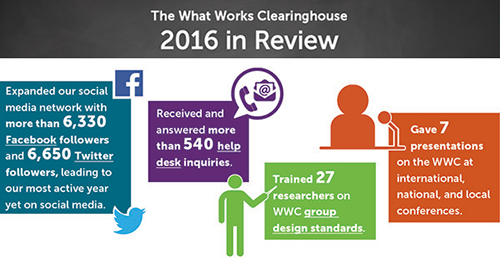In 2016, Mathematica continued to support the What Works Clearinghouse (WWC) in its mission to be a trusted source of evidence for educators. Mathematica has been working on the WWC with the Institute of Education Sciences at the U.S. Department of Education for more than a decade.
“This year, our staff helped the WWC create a variety of resources and tools to inform evidence-based decisions for schools and classrooms. Supporting these efforts, we continued to identify, assess, and synthesize the findings from high quality research. Together, the data and tools can help move our education system forward in improving outcomes for students,” said Neil Seftor, director of the WWC at Mathematica.
Highlights of 2016 include a redesigned WWC website featuring a tool that lets users Find What Works. The new tool helps identify programs, products, practices, and policies with the strongest evidence of effectiveness—an increasingly important goal in the era of evidence-based decision making. It also allows educators to narrow results for different populations and situations.
During the year, the WWC released quick reviews and intervention reports covering several topic areas, including math and literacy. The WWC also developed one-page evidence snapshots for more than 500 intervention reports. For teachers, practice guides provided detailed recommendations on “Foundational Skills to Support Reading for Understanding in Kindergarten Through 3rd Grade” and “Teaching Secondary Students to Write Effectively.” These guides blend research and practice to offer educators evidence-based recommendations for teaching and overcoming challenges in the classroom.
The WWC reached new users and audiences in 2016, as well. Greater outreach and engagement on Twitter and Facebook helped amplify the WWC’s evidence-based approach and methods. Audience-specific webinars, trainings, presentations, and professional conferences also connected new users with WWC products.
“As we enter another year of working with the WWC, Mathematica looks forward to our continued collaboration with the Institute of Education Sciences and our partners to encourage the development and use of high quality research. We will continue to look for innovative ways to help our nation’s students and educators find and use what works in education,” said Jill Constantine, senior vice president at Mathematica.

